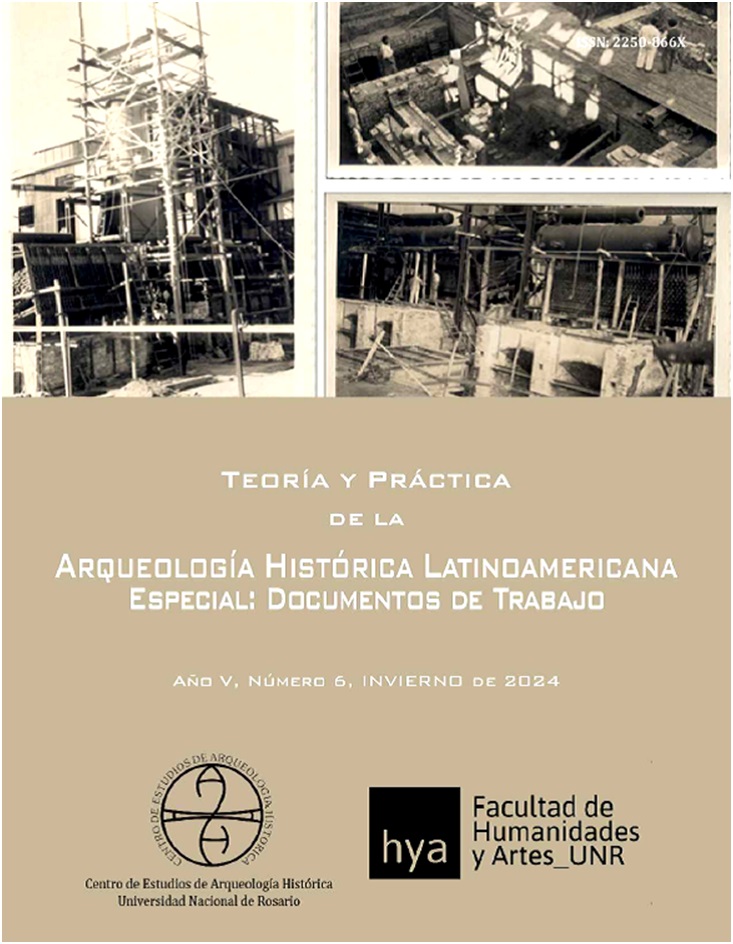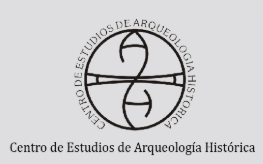Refractory Bricks in the Quebracho Extract Industry, Province of Santa Fe, Argentina
DOI:
https://doi.org/10.35305/tpahl.vi6.227Keywords:
quebracho extract industry, refractory bricks, trade namesAbstract
The establishment of the quebracho extract industry in the northern region of the province of Santa Fe, Argentina, allows us to investigate within the framework of historical archaeology a trajectory of capitalism along with the relationships and transformations of structures, artefacts and a new social order in the region. The new industry led to a considerable demand for refractory bricks, mostly from Great Britain and the United States, for the installation of boilers, ducts and chimneys. The aim of this work is to advance in the study of commercial brands, origins and commercialisation of refractory bricks identified in the towns of Villa Guillermina, La Gallareta, Tartagal, Villa Ana and Santa Felicia and in the rural area of Mocoví. The sample includes bricks identified in situ and in surface collections, as well as those provided by neighbours and cultural managers. For the determination of commercial brands and the study of the commercialisation of the product, primary sources and specialised bibliographic sources were analysed. This contribution is part of the research carried out within the framework of the Las Forestales y sus pueblos Project, which has been housed -since 2013- at the Centro de Estudios de Arqueología Histórica, Facultad de Humanidades y Artes, Universidad Nacional de Rosario.
Downloads
References
Barker, D. (2015). The other side of the melt: the Bradford area firebrick industry. Historical Metallurgy 48 (Parts 1 and 2) for 2014 (published 2015), p. 92–98.
De Noyelles, D. (1974). Brick Brands and Manufacturers of the Hudson River and the Metropolitan New York City Market. Privately printed. Nueva York: Thiells, New York.
Dorfman, A. 1942. Historia de la industria argentina. Buenos Aires, Hyspamerica.
Fernetti, G. (2022). Tijolos: a mudança na lama: Rosario, Argentina, 1870-1880. Vestígios Revista Latino-Americana de Arqueología Histórica, 16(1), 50–73.
Graham, D. & M. Oglethorpe (1993). Brick, Tile and Fireclay: Industries in Scotland. Publisher Royal Commission on the Ancient & Historical Monuments of Scotland.
Gurcke, K. (1987). Bricks and Brickmaking. A Handbook for Historical Archaeology. Moscow, Idaho, University of Idaho Press.
Harley, L. S. (1974). A Typology of Brick with Numerical Coding of Brick Characteristics. London, Journal of the British Archaeological Association, 3d Series; 38, 63-87. London.
Hicks, A. (1956): The Story of the Forestal, London, TheForestal Land, Timber and Railways Company Limited.Londres.
Johnson, M. (1996). An Archaeology of Capitalism, Oxford,: Blackwell.
Kelly R. &M. Kelly (1977). Brick Bats for Archaeologists: Values of Pressed Brick Brands. Historical Archaeology, 11, 84–89, Published by Springer.
Otero, O. (2008). Materiales y tecnologías empleadas en Buenos Aires en tiempos virreinales. LEMIT (Laboratorio de Entrenamiento Multidisciplinario para la Investigación Tecnológica). La Plata.
Palmer, M. & P. Neaverson (2001). Industrial Archaeology: Principles and Practice. London and New York. Routledge.
Pasquali C. y P. Milicic (2019). Ladrillos refractarios en la industria taninera (Provincia de Santa Fe. Argentina). Primeras Jornadas de Práctica Arqueológica. Facultad de Humanidades y Artes. Universidad Nacional de Rosario.
Pasquali, C. (2020). “Las forestales”. Origen de la industria del tanino en la provincia de Santa Fe (Argentina). Trabajo final, Curso de Posgrado Historia Social y Económica Argentina, Departamento de Sociología, Pontificia Universidad Católica Argentina, Buenos Aires.
Pasquali, C. y P. Milicic (2021). Fábricas de extracto de quebracho. Santa Felicia y Mocoví (Provincia de Santa Fe). Una aproximación desde la Arqueología Histórica. Revista Teoría y Práctica de la Arqueología Histórica Latinoamericana, 13, 81-95.
Pasquali, C. (2022). “De aserrín a extracto”. Antecedentes históricos de la industria del extracto de quebracho colorado en la provincia de Santa Fe (Argentina). Travesía, Vol. 24, Nº (2), 99-127.
Rocchi, F. (2000). El péndulo de la riqueza: la economía argentina en el período 1880-1916, en Mirta Zaida Lobato (ed.), Nueva historia argentina, Buenos Aires, Sudamericana.
Rodríguez, M. y M. Giménez Yanguas (1987). Los catálogos comerciales de empresas productoras de equipos, una posible fuente para el estudio de nuestra reciente historia económica: el catálogo de la caldera de vapor Badcock & Wilcox, 1896.
Revista de Estudios Regionales. Universidades Públicas de Andalucía, Vol. 2, 237-250.
Scháavelzon, D. (2001). Catálogo de Cerámicas Históricas de Buenos Aires (Siglos XVI-XX). Con notas sobre la región del Río de la Plata. Facultad de Arquitectura, Diseño y Urbanismo. Universidad de Buenos Aires. La Imprenta Digital S.R.L.
Stuart, I. (2005). Archaeological Sites in Australia. Australasian Historical Archaeology, 23.
Tomassini, H. y J; Weimann (2003). Estudios mineralógicos y morfológicos en ladrillos de asentamientos rurales (sur bonaerense, siglo XIX). Relaciones 48(1), Buenos Aires, Sociedad Argentina de Antropología (SAA).
Traversa L., O. Otero y C. Pittori (2003). Estudios tecnológicos de ladrillos cerámicos comunes pertenecientes al patrimonio construido bonaerense. La Plata, LEMIT (Laboratorio de Entrenamiento Multidisciplinario para la Investigación Tecnológica).

Downloads
Published
How to Cite
Issue
Section
License
Copyright (c) 2024 Teoría y Práctica de la Arqueología Histórica Latinoamericana

This work is licensed under a Creative Commons Attribution-NonCommercial-ShareAlike 4.0 International License.






